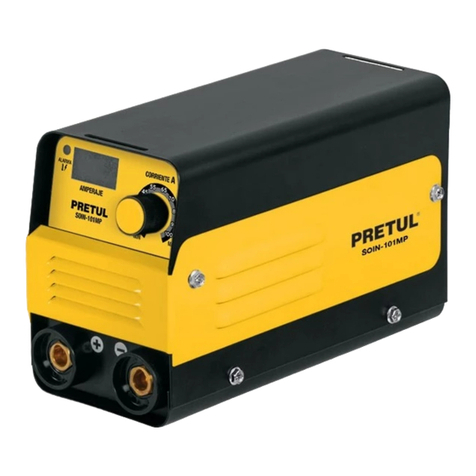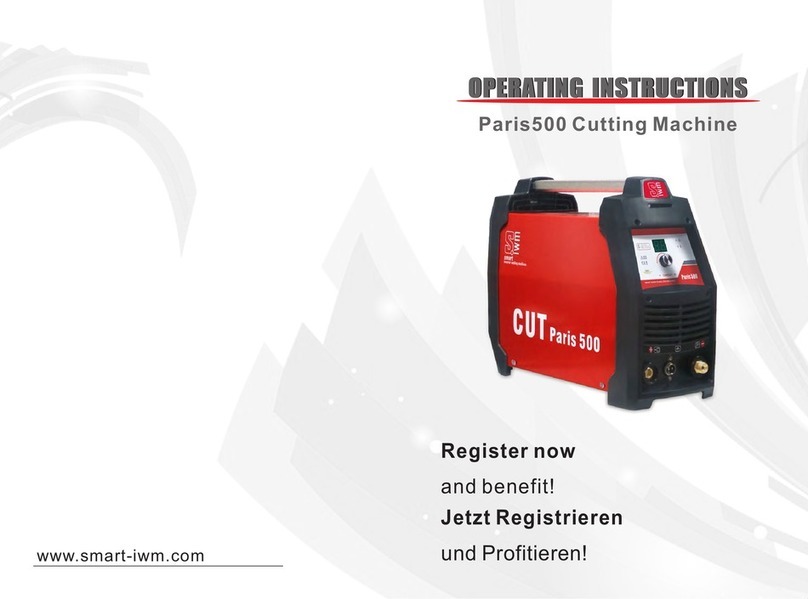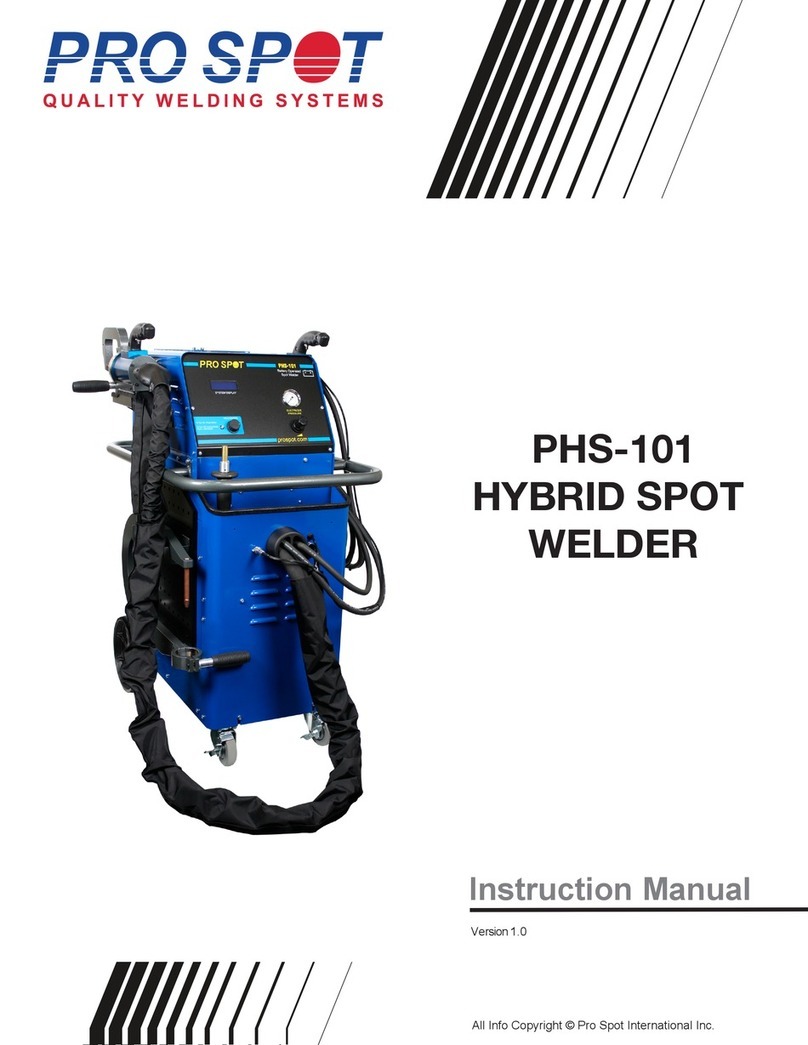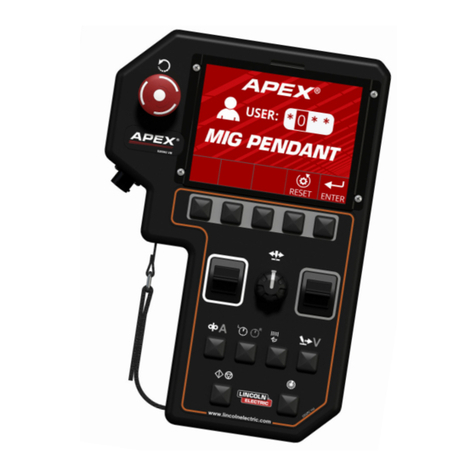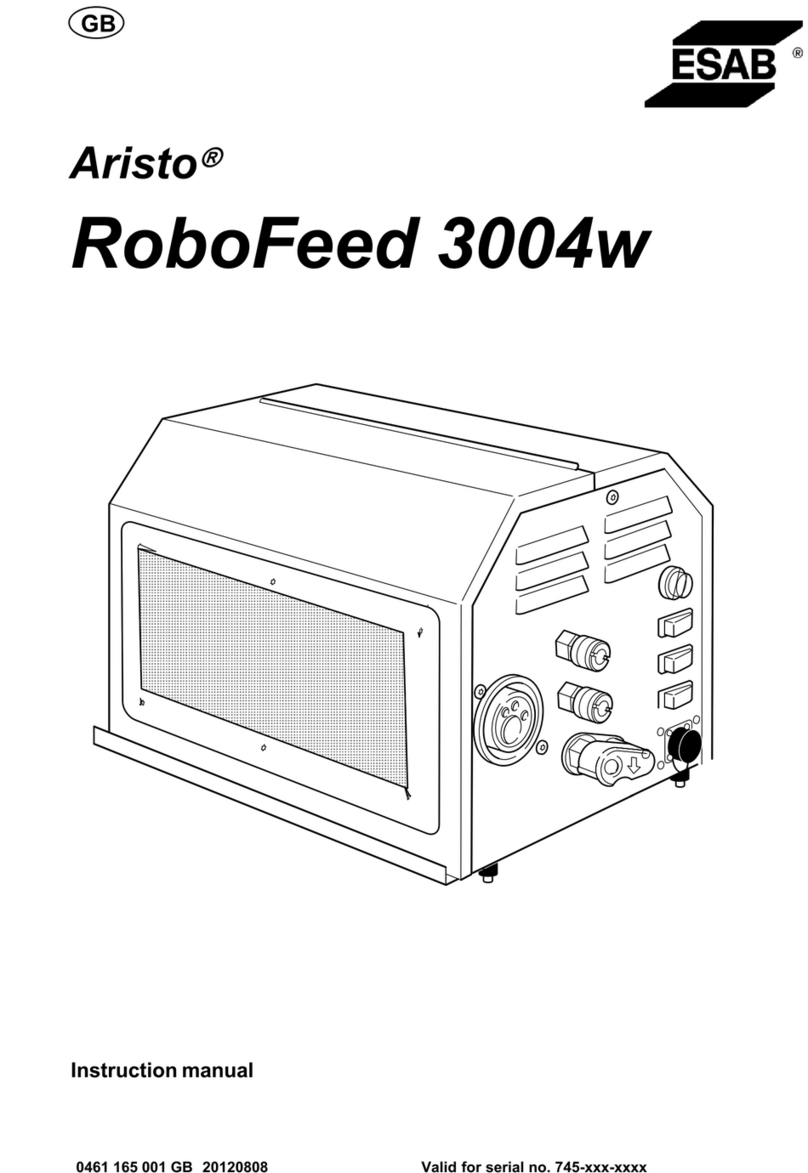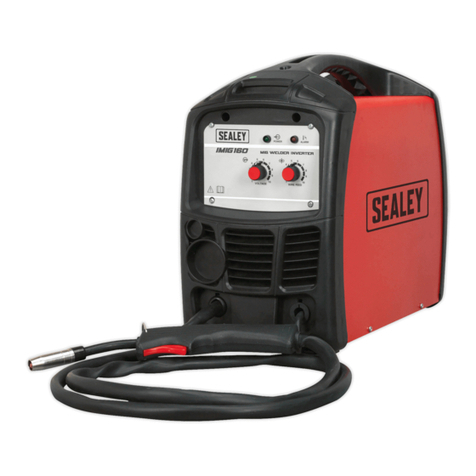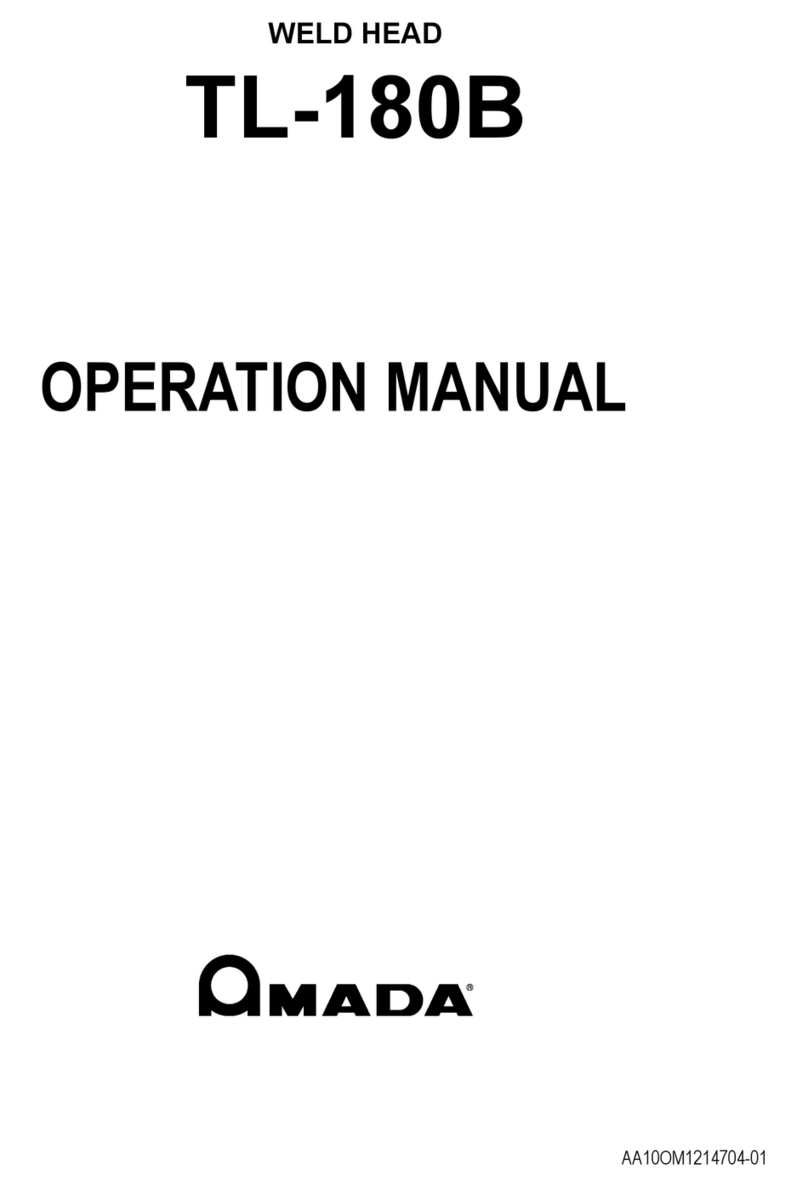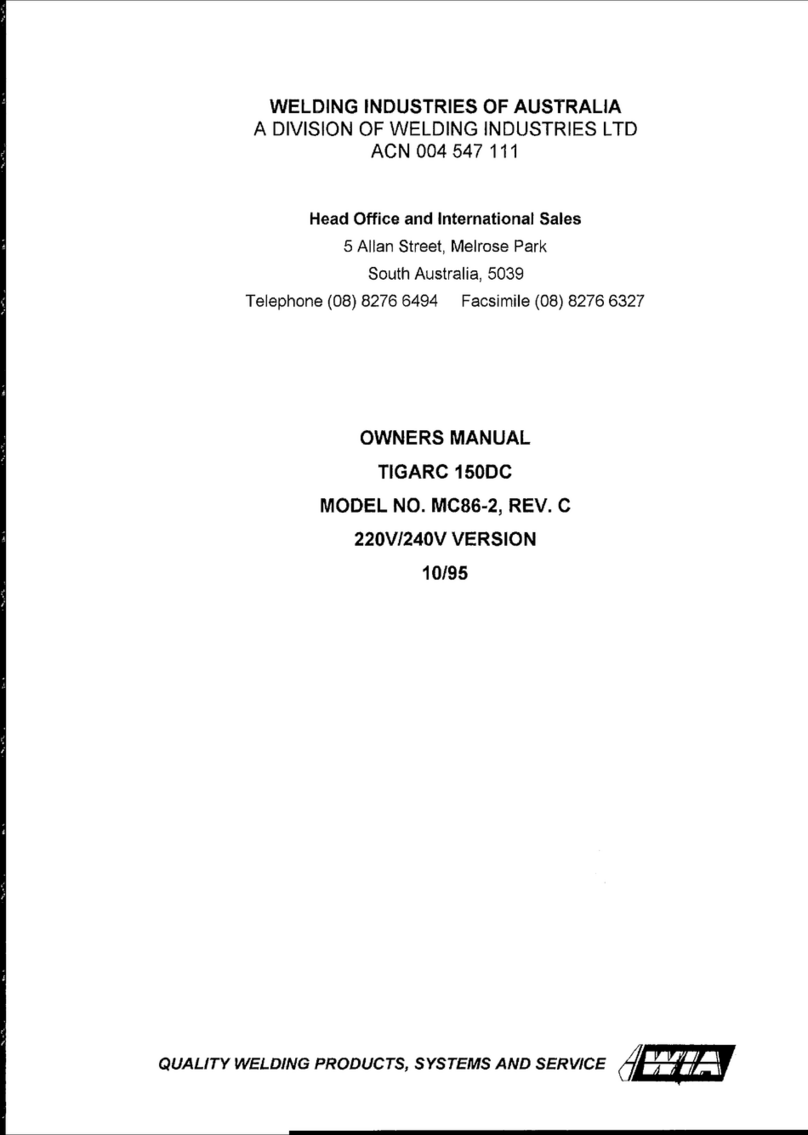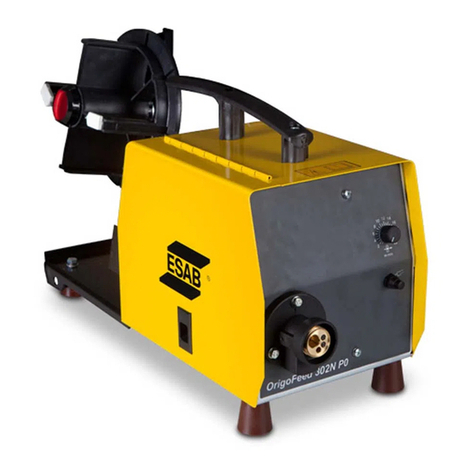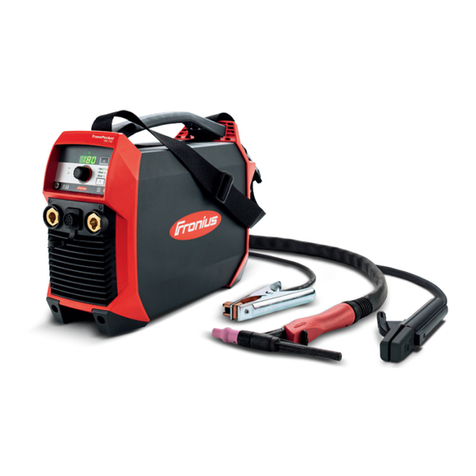PRETUL CORSOL-P User manual

Manual
Read the user’s manual
thoroughlybefore
operating this tool.
Cutting and
Welding Equipment
CORSOL-P
Model Code
CORSOL-P
Applies for:
21576
Heavy Duty
ENGLISH
ESPAÑOL
CAUTION

2
Safety Warnings
Parts
Setting up
Pressure Adjustments
Start up
Troubleshooting
Notes
3
4
5
6
8
9
10
CORSOL-P
ENGLISH
CAUTION
Contents
Keep this manual for future references.
The illustrations in this manual are for reference
only. They might be different from the real tool.
To gain the best performance of
the tool, prolong the duty life,
make the Warranty valid if
necessary, and to avoid hazards
of fatal injuries please read and
understand this Manual before
using the tool.

There are many risks associated with the use of oxyacetylene welding. Appropriate safety
measures should be taken when working with this equipment.
• Never use oxygen to air-blow the
workplace or your clothes. Any spark may cause a fire.
• Do not work with damaged or leaking equipment.
• Do not use the torch as a hammer or to remove burrs
from work material.
3
• Before welding or cutting, make sure that the working
area is in perfect conditions to avoid accidents.
• Work in well-ventilated areas.
Work Area
• Always keep a fire extinguisher handy.
• Use reverse flow check valves or check
valves on all connections. These safety valves help prevent
accidents caused by gas backflow or flame blowback
in the system.
• Always use welding glasses to protect your eyes from
sparks or flares.
• Always wear special welding gloves and watch out for
sparks that could fall into your wrists.
• Do not wear torn or broken
clothing: a spark could ignite the fabric.
Safety equipment
• Do not smoke near the cylinders.
• Handle the cylinders with care. Avoid
dropping or hitting them and do not expose them to heat
or flame. Remember that the cylinders must always be in
an upright position.
• Secure the cylinders in place before
making connections to prevent them from falling out. It is
recommended that they be mounted and chained to a
loading trolley.
• Never use a cylinder that is dented.
• Cylinder protection caps should be in place whenever
you move the cylinders or when you are not using them.
• Empty cylinders must be stored in a specific location and
clearly marked as "Empty"”.
• Under no circumstances should you alter or force the
cylinder connections.
Cylinder handling
• Do not smoke near the connections.
• Do not use oil or grease on the
connections under any circumstances. The equipment
does not require lubrication. Oil and lubricants burn
violently in the presence of pressurized oxygen.
• Make sure that all connections and
hoses are in good condition. Replace any damaged ones
immediately.
• When installing the connections, make sure that they are
tight.
• Use soapy water to detect any
leaks and correct them before turning on.
• Under no circumstances allow damaged
or missing "O" rings on the cone tip. Should this happen,
gases will mix inside the material, which could cause the
flame to be reversed or an explosion to occur.
Connections
• Purge the oxygen and acetylene
passages separately before switching on (see page 5 and
6).
• Avoid wasting gas by using the proper pressure settings.
If gauges indicate external pressure, correct immediately.
• The working pressure in the acetylene gauge should
NEVER exceed 15 PSI (1.03 bar).
• Purge the entire system after each use
(see page 9). DO NOT disconnect the equipment with the
cylinder valves open.
• In case of a leak, move the cylinder to an open area away
from flammable material and immediately report it to your
supervisor or to Civil Protection.
Pressure
Restrictions on use
Safety Warnings
ENGLISH
CAUTION
CAUTION
CAUTION
CAUTION
CAUTION
CAUTION
CAUTION
CAUTION
CAUTION
CAUTION
WARNING
WARNING
WARNING
WARNING
WARNING
WARNING

4
Casserole
lighter
Brass
torch
Nozzle
opener
Cutting Nozzle #4
Welding
Nozzle
Shade protection
lenses #10
Acetylene gauge
with
control valve
Regulating
knob
Check valve
(not included)
Check valve
(not included)
Regulating
knob
Oxygen gauge
with
control valve
14.7 ft double
oxyacetylene hose
Multi-purpose
wrench
Casserole lighter
spare parts
Cutting
control
Parts
ENGLISH

6. Clean the inside of each hose by slowly opening the cylinder valve to 34.4 kPa (5 PSI) (0.34 bar).
Allow the gas to flow for 10 seconds to expel any debris from the inside of the hose and close the valve.
Repeat the procedure with the other hose. The valve of the acetylene cylinder must not be turned more
than one turn when opening it.
7. Connect the hoses to the corresponding holes in the torch. Tighten the couplings firmly with a wrench.
8. Connect the welding nozzle or
cutting torch to the torch.
9. Apply soap solution to all
connections to detect possible leaks.
Open valves on both cylinders and
correct any leaks by tightening
connections. If leakage persists, stop
work and contact your supplier.
5
• Make sure you are in a place free of flames and sparks
when preparing the equipment.
• Before making connections, be sure to remove any dust or
dirt particles from the outlet valves of both cylinders. Stand to one side of the
tank and open the valve (A) for two seconds to expel any particles that may
enter the system causing damage or accidents.
• If you detect grease or oil, do not use the cylinder at all and
contact the manufacturer or distributor of the cylinder.
1. Vertical or secured cylinders.
2. Gauges connected to the corresponding gas. Use a
wrench for a firm connection. Be sure to tighten them in
the correct direction: usually clockwise for oxygen,
counterclockwise for acetylene.
3. It is recommended to use check valves connected to
the gauges.
4. Hoses connected to the valves. Green is for oxygen and
red is for acetylene. Tighten the couplings firmly with a
wrench. If you detect any signs of grease or oil, stop use
immediately.
5. Fully open the gauge handles by turning them
counterclockwise. If you do not do this,
the pressure in the cylinder may damage the gauges.
1
4
2
A
7
6
9
5
3
8
Setting up
ENGLISH
CAUTION
CAUTION
CAUTION
CAUTION
CAUTION

Setting up
Pressure Adjustments
6
10. Set the appropriate oxygen pressure for the job to be
performed according to the tables in the following section.
11. Open the oxygen valve on the torch for two seconds
and close it.
12. Adjust the acetylene pressure suitable for the job to be
performed according to the tables in the following section.
To obtain better results in consumption and performance of the equipment, it is recommended that
you adhere to the pressures indicated in the tables.
11
10 12
SOLDERING TIPS
Metal thickness
(mm)
Nozzle
number Minimum Maximum
ACETYLENE pressure
(kPa - PSI - bar)
OXYGEN pressure
(kPa - PSI - bar) Minimum Maximum
0.4 - 1.2
(1/64” - 3/64”)
0.8 - 2
(1/32” - 5/64”)
1.2 - 2.4
(3/64” - 3/32”)
1.6 - 3.2
(1/16” - 1/8”)
3.2 - 4.8
(1/8” - 3/16”)
4.8 - 6.3
(3/16” - 1/4”)
6.3 - 12.7
(1/4” - 1/2”)
00
0
1
2
3
4
5
20.6 kPa
(3 PSI)(0.21 bar)
20.6 kPa
(3 PSI)(0.21 bar)
20.6 kPa
(3 PSI)(0.21 bar)
20.6 kPa
(3 PSI)(0.21 bar)
27.5 kPa
(4 PSI)(0.27 bar)
34.4 kPa
(5 PSI)(0.34 bar)
41.3 kPa
(6 PSI)(0.41 bar)
34.4 kPa
(5 PSI)(0.345 bar)
34.4 kPa
(5 PSI)(0.345 bar)
34.4 kPa
(5 PSI)(0.345 bar)
34.4 kPa
(5 PSI)(0.345 bar)
48.2 kPa
(7 PSI)(0.48 bar)
68.9 kPa
(10 PSI)(0.69 bar)
82.7 kPa
(12 PSI)(0.83 bar)
20.6 kPa
(3 PSI)(0.2 bar)
20.6 kPa
(3 PSI)(0.2 bar)
20.6 kPa
(3 PSI)(0.2 bar)
20.6 kPa
(3 PSI)(0.2 bar)
20.6 kPa
(3 PSI)(0.2 bar)
27.5 kPa
(4 PSI)(0.27 bar)
27.5 kPa
(4 PSI)(0.27 bar)
34.4 kPa
(5 PSI)(0.34 bar)
34.4 kPa
(5 PSI)(0.34 bar)
34.4 kPa
(5 PSI)(0.34 bar)
34.4 kPa
(5 PSI)(0.34 bar)
41.3 kPa
(6 PSI)(0.41 bar)
41.3 kPa
(6 PSI)(0.41 bar)
48.2 kPa
(7 PSI)(0.48 bar)
ENGLISH
CAUTION

7
Pressure Adjustments
Minimum Maximum Minimum Maximum
OXYACETYLENE CUTTING NOZZLES
Metal thickness
(mm)
Nozzle
number
OXYGEN
pressure
(kPa - PSI - bar)
ACETYLENE
pressure
(kPa - PSI - bar)
3.1 - 6.3
(1/8” - 1/4”)
9.5
(3/8”)
12.7 - 25.4
(1/2” - 1”)
50.8
(2”)
76.2 - 101.6
(3” - 4”)
170
(6 1/2”)
250
(10”)
300
(12”)
00
0
1
2
3
4
5
6
172.3 kPa - 241.3 kPa
(25 PSI - 35 PSI) (1.7 bar - 2.4 bar)
172.3 kPa - 241.3 kPa
(25 PSI - 35 PSI) (1.7 bar - 2.4 bar)
241.3 kPa - 310.2 kPa
(35 PSI - 45 PSI) (2.4 bar - 3.1 bar)
310.2 kPa - 344.7 kPa
(45 PSI - 50 PSI) (3.1 bar - 3.4 bar)
310.2 kPa - 379.2 kPa
(45 PSI - 55 PSI) (3.1 bar - 3.7 bar)
379.2 kPa - 448.1 kPa
(55 PSI - 65 PSI) (3.7 bar - 4.4 bar)
572.2 kPa
(83 PSI) (5.72 bar)
689.4 kPa
(100 PSI) (6.89 bar)
41.3 kPa
(6 PSI) (0.41 bar)
41.3 kPa
(6 PSI) (0.41 bar)
41.3 kPa
(6 PSI) (0.41 bar)
41.3 kPa
(6 PSI) (0.41 bar)
41.3 kPa
(6 PSI) (0.41 bar)
41.3 kPa
(6 PSI) (0.41 bar)
41.3 kPa
(6 PSI) (0.41 bar)
41.3 kPa
(6 PSI) (0.41 bar)
HEATING TIPS WITH MULTIPLE OXYACETYLENE FLAME
Nozzle
No.
OXYGEN
pressure
(kPa - PSI - bar)
ACETYLENE
(l/h - ft3/h)
ACETYLENE
pressure
(kPa - PSI - bar)
OXYGEN
(l/h - ft3/h)
6
8
27.5 kPa - 41.3 kPa
(4 PSI - 6 PSI)
(0.27 bar - 0.41 bar)
55.1 kPa - 82.7 kPa
(8 PSI - 12 PSI)
(0.55 bar - 0.83 bar)
55.1 kPa - 75.8 kPa
(8 PSI - 11 PSI)
(0.55 bar - 0.76 bar)
68.9 kPa - 124.1 kPa
(10 PSI - 18 PSI)
(0.69 bar - 1.24 bar)
396.4 l/h
(14 ft3/h)
849.4 l/h
(30 ft3/h)
1 132.6 l/h
(40 ft3/h)
2 265.2 l/h
(80 ft3/h)
424.7 l/h
(15 ft3/h)
934.4 l/h
(33 ft3/h)
1 245.9 l/h
(44 ft3/h)
2 491.8 l/h
(88 ft3/h)
ENGLISH

8
1. Open the ACETYLENE valve on the torch approximately 1/2
turn.
2. Use the casserole lighter to start the flame.
3. Turn the ACETYLENE valve on the torch until excess black
smoke is cleared.
4. Open the OXYGEN valve of the torch until the neutral flame (A)
appears.
Never raise the pressure in the acetylene
gauge above 103.4 kPa (15 PSI) (1.03) bar).
To turn on
Start up
Oxidizing flame
(excess oxigen)
Neutral flame
(perfect gasses balance)
Pre-heating
dart
Fuel flame
(acetylene in excess)
1
3
4
A
2
ENGLISH
CAUTION

9
Start up
Troubleshooting
• Bring the flame closer to the piece you're going to cut.
• Place the tip of the preheat dart on top of the material.
• Heat the material up to the "bright red".
• Slowly press the oxygen lever to start the cut.
• Move the nozzle of the torch in the direction required for
the cut.
In the case of handles, open the oxygen
valve completely for better performance.
To cut
• Close the oxygen valve on the torch.
• Close the acetylene valve on the torch.
• Close the valves on both cylinders.
• Open the torch acetylene valve to drain the line and close
the valve.
• Open the oxygen valve of the torch to empty the line and
close the valve.
• Release the gauge handles by turning them
counterclockwise.
To turn off
Welding nozzle is
thrown away.
The flame is not clearly
defined, not uniform or
even.
Gauge pressure is no
constant.
The cutting nozzle is
thrown away.
There's dripping around
the control valve.
It's difficult to light the
torch.
The flame changes
when you cut.
• The line pressure is too low.
• The nozzle is too long.
• It's too close to the work
piece.
• The nozzle is dirty.
• The seal is defective.
• The nozzle is loose.
• The seal is pinched.
• The gauge handle is loose.
• There's too much pressure
on the line.
• The oxygen control valve is
partially closed.
• The oxygen cylinder is
almost empty.
• Increase line pressure. See tables on pages 6 and 7.
• Use the next smaller nozzle size.
• Move nozzle away from workpiece.
• Use the nozzle opener to clean it.
• Go to a Authorized Service
Center to repleace the gauge.
• Tighten the nozzle.
• Replace the nozzle.
• Tighten the handle.
• Decrease the line pressure. See tables on pages 6
and 7.
• Open the oxygen control valve further.
• Replace the oxygen cylinder with a full one.
Problem Cause Solution
ENGLISH
CAUTION

Notes
10

11
Notes

For questions or comments, please call 800 0187873.
Imported by: Truper, S.A. de C.V.
Parque Industrial #1, Jilotepec, Edo. de Méx., Méx. ZIP 54240.
Made in China.
www.truper.com
06-2020
ENGLISH
12

Para dudas o comentarios, llame al 800 0187873.
Importado por: Truper, S.A. de C.V.
Parque Industrial #1, Jilotepec, Edo. de Méx., Méx. C.P. 54240.
Hecho en China.
www.truper.com
06-2020
ESPAÑOL
12

11
Notas

Notas
10

9
Puesta en marcha
Solución de problemas
• Acerque la flama a la pieza que va a cortar.
• Coloque la punta del dardo de precalentamiento arriba
del material.
• Caliente el material hasta el “rojo vivo”.
• Presione lentamente la palanca de oxígeno para iniciar el
corte.
• Desplace la boquilla del soplete en la dirección que
requiera el corte.
En caso de manerales abra completa-
mente la válvula de oxígeno para un mejor desempeño.
Corte
• Cierre la válvula de oxígeno de la antorcha.
• Cierre la válvula de acetileno de la antorcha.
• Cierre las válvulas de los dos cilindros.
• Abra la válvula de acetileno de la antorcha para vaciar la
línea y cierre la válvula.
• Abra la válvula de oxígeno de la antorcha para vaciar la
línea y cierre la válvula.
• Libere las manijas de los reguladores girándolas en
sentido contrario a las manecillas del reloj.
Apagado
La boquilla para
soldar se bota.
La flama no está
claramente definida, no es
uniforme o pareja.
La presión en el regulador
no es constante.
La boquilla de
corte se bota.
Hay goteo alrededor de
la válvula de control.
Es difícil encender
el soplete.
La flama cambia al
cortar.
• La presión de la línea es
demasiado baja.
• La boquilla es demasiado
larga.
• Está demasiado cerca de la
pieza de trabajo.
• La boquilla está sucia.
• El sello está defectuoso.
• La boquilla está floja.
• El sello está picado.
• La manija del regulador está
suelta.
• Hay demasiada presión en la
línea.
• La válvula de control de
oxígeno está parcialmente
cerrada.
• El cilindro de oxígeno está
casi vacío.
• Incremente la presión de la línea. Consulte las tablas
de las páginas 6 y 7.
• Use el tamaño de boquilla inmediato inferior.
• Aleje la boquilla de la pieza de trabajo.
• Use el destapador de boquillas para limpiarla.
• Acuda a un Centro de Servicio Autorizado
para reemplazar el regulador.
• Apriete la boquilla.
• Reemplace la boquilla.
• Apriete la manija.
• Disminuya la presión de la línea. Consulte las tablas
de las páginas 6 y 7.
• Abra más la válvula de control de oxígeno.
• Reemplace el cilindro de oxígeno por uno lleno.
Problema Causa Solución
ATENCIÓN
ESPAÑOL

8
1. Abra la válvula de ACETILENO de la antorcha 1/2 vuelta
aproximadamente.
2. Utilice el encendedor de cazuela para iniciar la flama.
3. Gire la válvula de ACETILENO de la antorcha hasta eliminar
el exceso de humo negro.
4. Abra la válvula de OXÍGENO de la antorcha hasta que
aparezca la flama neutra (A).
Nunca eleve la presión en el regulador de
acetileno a más de 103.4 kPa (15 PSI) (1.03 bar).
Encendido
Puesta en marcha
Flama oxidante
(exceso de oxígeno)
Flama neutra
(balance perfecto de gases)
Dardo de
precalentamiento
Flama carburante
(exceso de acetileno)
1
3
4
A
2
ATENCIÓN
ESPAÑOL

7
Ajuste de presiones
Mínima Máxima Mínima Máxima
BOQUILLAS DE CORTE CON OXI-ACETILENO
Espesor del
metal (mm)
No. de
boquilla
Presión de
OXÍGENO
(kPa - PSI - bar)
Presión de
ACETILENO
(kPa - PSI - bar)
3.1 - 6.3
(1/8” - 1/4”)
9.5
(3/8”)
12.7 - 25.4
(1/2” - 1”)
50.8
(2”)
76.2 - 101.6
(3” - 4”)
170
(6 1/2”)
250
(10”)
300
(12”)
00
0
1
2
3
4
5
6
172.3 kPa - 241.3 kPa
(25 PSI - 35 PSI) (1.7 bar - 2.4 bar)
172.3 kPa - 241.3 kPa
(25 PSI - 35 PSI) (1.7 bar - 2.4 bar)
241.3 kPa - 310.2 kPa
(35 PSI - 45 PSI) (2.4 bar - 3.1 bar)
310.2 kPa - 344.7 kPa
(45 PSI - 50 PSI) (3.1 bar - 3.4 bar)
310.2 kPa - 379.2 kPa
(45 PSI - 55 PSI) (3.1 bar - 3.7 bar)
379.2 kPa - 448.1 kPa
(55 PSI - 65 PSI) (3.7 bar - 4.4 bar)
572.2 kPa
(83 PSI) (5.72 bar)
689.4 kPa
(100 PSI) (6.89 bar)
41.3 kPa
(6 PSI) (0.41 bar)
41.3 kPa
(6 PSI) (0.41 bar)
41.3 kPa
(6 PSI) (0.41 bar)
41.3 kPa
(6 PSI) (0.41 bar)
41.3 kPa
(6 PSI) (0.41 bar)
41.3 kPa
(6 PSI) (0.41 bar)
41.3 kPa
(6 PSI) (0.41 bar)
41.3 kPa
(6 PSI) (0.41 bar)
PUNTAS DE CALENTAMIENTO CON MÚLTIPLE FLAMA DE OXIACETILENO
No. de
boquilla
Presión de
OXÍGENO
(kPa - PSI - bar)
ACETILENO
(l/h - ft3/h)
Presión de
ACETILENO
(kPa - PSI - bar)
OXÍGENO
(l/h - ft3/h)
6
8
27.5 kPa - 41.3 kPa
(4 PSI - 6 PSI)
(0.27 bar - 0.41 bar)
55.1 kPa - 82.7 kPa
(8 PSI - 12 PSI)
(0.55 bar - 0.83 bar)
55.1 kPa - 75.8 kPa
(8 PSI - 11 PSI)
(0.55 bar - 0.76 bar)
68.9 kPa - 124.1 kPa
(10 PSI - 18 PSI)
(0.69 bar - 1.24 bar)
396.4 l/h
(14 ft3/h)
849.4 l/h
(30 ft3/h)
1 132.6 l/h
(40 ft3/h)
2 265.2 l/h
(80 ft3/h)
424.7 l/h
(15 ft3/h)
934.4 l/h
(33 ft3/h)
1 245.9 l/h
(44 ft3/h)
2 491.8 l/h
(88 ft3/h)
ESPAÑOL

Preparación
Ajuste de presiones
6
10. Ajuste la presión del oxígeno adecuada para el trabajo
a realizar de acuerdo a las tablas de la siguiente sección.
11. Abra la válvula de oxígeno de la antorcha por dos
segundos y cierre.
12. Ajuste la presión del acetileno adecuada para el trabajo
a realizar de acuerdo a las tablas de la siguiente sección.
Para obtener mejores resultados de consumo y desempeño del equipo se recomienda apegarse a las
presiones indicadas en las tablas.
ATENCIÓN
11
10 12
PUNTAS PARA SOLDAR
Espesor del
metal (mm)
No. de
boquilla Mínima Máxima
Presión de ACETILENO
(kPa - PSI - bar)
Presión de OXÍGENO
(kPa - PSI - bar) Mínima Máxima
0.4 - 1.2
(1/64” - 3/64”)
0.8 - 2
(1/32” - 5/64”)
1.2 - 2.4
(3/64” - 3/32”)
1.6 - 3.2
(1/16” - 1/8”)
3.2 - 4.8
(1/8” - 3/16”)
4.8 - 6.3
(3/16” - 1/4”)
6.3 - 12.7
(1/4” - 1/2”)
00
0
1
2
3
4
5
20.6 kPa
(3 PSI)(0.21 bar)
20.6 kPa
(3 PSI)(0.21 bar)
20.6 kPa
(3 PSI)(0.21 bar)
20.6 kPa
(3 PSI)(0.21 bar)
27.5 kPa
(4 PSI)(0.27 bar)
34.4 kPa
(5 PSI)(0.34 bar)
41.3 kPa
(6 PSI)(0.41 bar)
34.4 kPa
(5 PSI)(0.345 bar)
34.4 kPa
(5 PSI)(0.345 bar)
34.4 kPa
(5 PSI)(0.345 bar)
34.4 kPa
(5 PSI)(0.345 bar)
48.2 kPa
(7 PSI)(0.48 bar)
68.9 kPa
(10 PSI)(0.69 bar)
82.7 kPa
(12 PSI)(0.83 bar)
20.6 kPa
(3 PSI)(0.2 bar)
20.6 kPa
(3 PSI)(0.2 bar)
20.6 kPa
(3 PSI)(0.2 bar)
20.6 kPa
(3 PSI)(0.2 bar)
20.6 kPa
(3 PSI)(0.2 bar)
27.5 kPa
(4 PSI)(0.27 bar)
27.5 kPa
(4 PSI)(0.27 bar)
34.4 kPa
(5 PSI)(0.34 bar)
34.4 kPa
(5 PSI)(0.34 bar)
34.4 kPa
(5 PSI)(0.34 bar)
34.4 kPa
(5 PSI)(0.34 bar)
41.3 kPa
(6 PSI)(0.41 bar)
41.3 kPa
(6 PSI)(0.41 bar)
48.2 kPa
(7 PSI)(0.48 bar)
ESPAÑOL

6. Limpie el interior de cada manguera abriendo lentamente la válvula del cilindro hasta alcanzar 34.4 kPa (5 PSI) (0.34 bar).
Permita que el gas fluya por 10 segundos para expulsar cualquier residuo del interior de la manguera y cierre la válvula.
Repita el procedimiento con la otra manguera. La válvula del cilindro de acetileno no debe ser girada más
de una vuelta al abrirla.
7. Conecte las mangueras a los orificios correspondientes en la antorcha. Apriete firmemente los coples con una llave.
8. Conecte en la antorcha la boquilla
para soldar o el soplete para cortar.
9. Aplique solución jabonosa en todas
las conexiones para detectar posibles
fugas. Abra las válvulas de ambos
cilindros y corrija cualquier fuga
apretando las conexiones. Si la fuga
persiste, interrumpa el trabajo y
contacte a su proveedor.
5
• Asegúrese de estar en un lugar libre de flamas y chispas
al preparar el equipo.
• Antes de realizar las conexiones asegúrese de eliminar las
partículas de polvo o suciedad acumuladas en las válvulas de salida de ambos
cilindros. Colóquese a un lado del tanque y abra la válvula (A) por dos
segundos para que expulse cualquier partícula que pueda entrar al sistema
causando daños o accidentes.
• Si detecta grasa o aceite, no use el cilindro en lo absoluto
y póngase en contacto con el fabricante o distribuidor del mismo.
1. Cilindros verticales y asegurados.
2. Reguladores conectados al gas correspondiente.
Utilice una llave para una conexión firme. Asegúrese de
apretarlos en la dirección correcta: generalmente, en
sentido de las manecillas del reloj el de oxígeno y el de
acetileno en sentido contrario.
3. Se recomienda utilizar válvulas check conectadas a los
reguladores.
4. Mangueras conectadas a las válvulas. La verde es para
el oxígeno y la roja para el acetileno. Apriete firmemente
los coples con una llave. Si detecta cualquier indicio de
grasa o aceite, interrumpa su uso inmediatamente.
5. Abra por completo las manijas de los reguladores
girándolas en sentido contrario a las manecillas del reloj.
De no hacer esto, la presión del
cilindro puede estropear el regulador.
ATENCIÓN
ATENCIÓN
ATENCIÓN
1
4
2
A
7
6
9
5
3
8
Preparación
ATENCIÓN
ATENCIÓN
ESPAÑOL
This manual suits for next models
1
Table of contents
Other PRETUL Welding System manuals
Popular Welding System manuals by other brands

Lincoln Electric
Lincoln Electric COUGAR K2704-2 Operator's manual
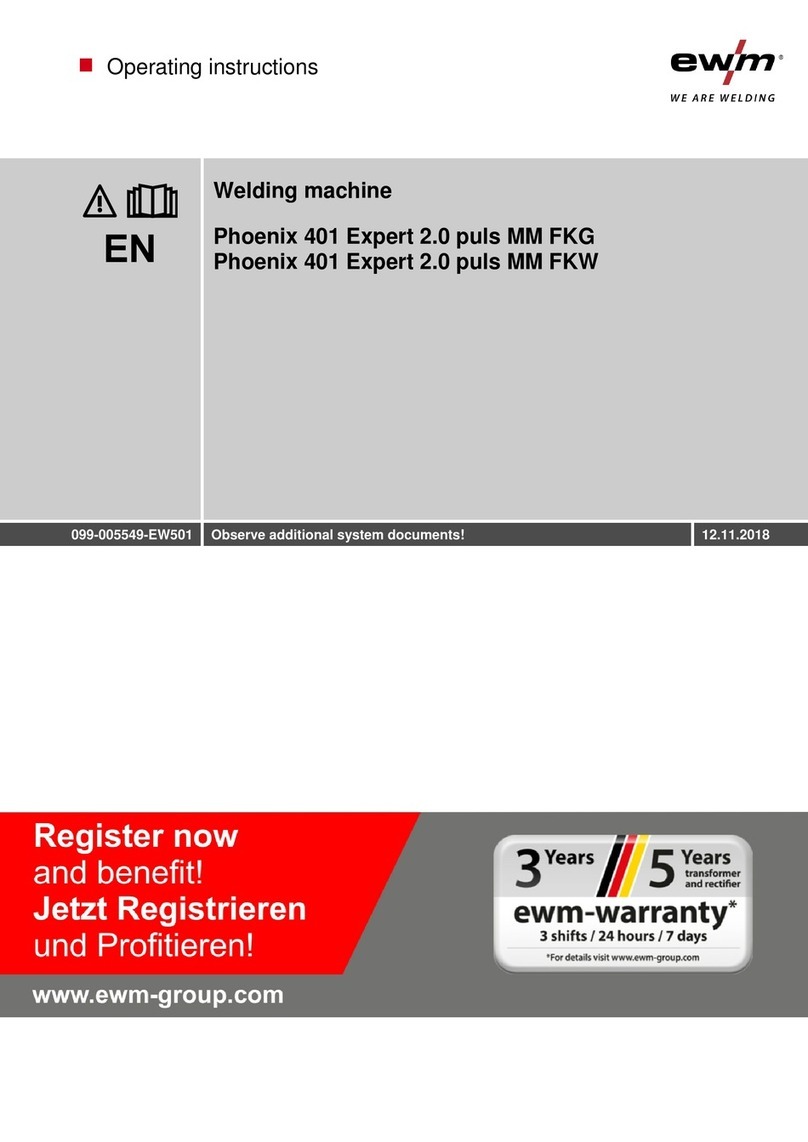
EWM
EWM Phoenix 401 Expert 2.0 puls MM FKG operating instructions
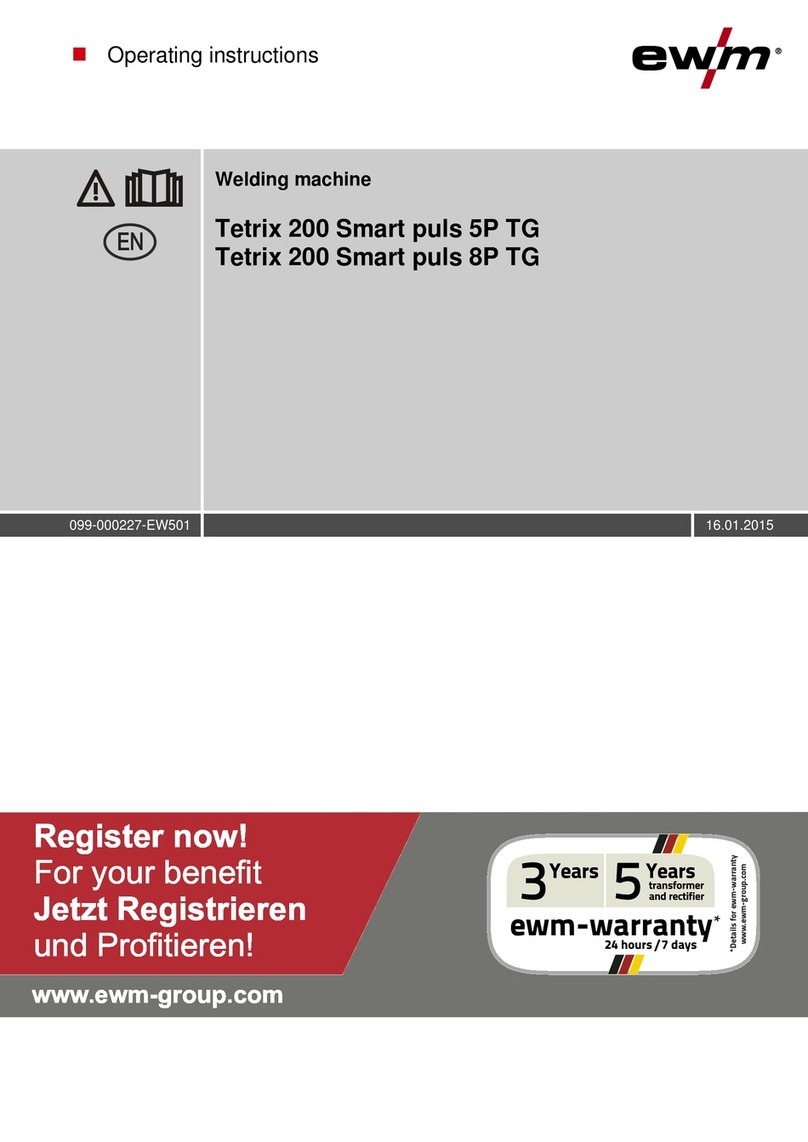
EWM
EWM Tetrix 200 Smart puls 5P TG operating instructions
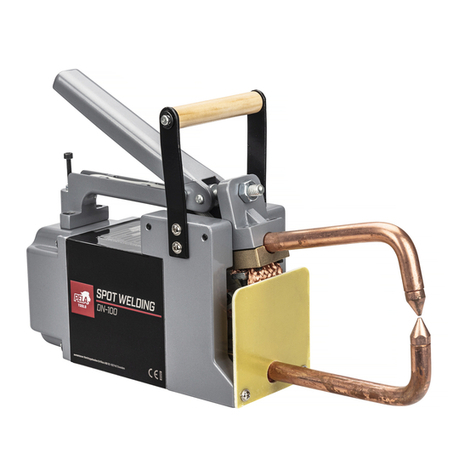
pela tools
pela tools 513137 manual
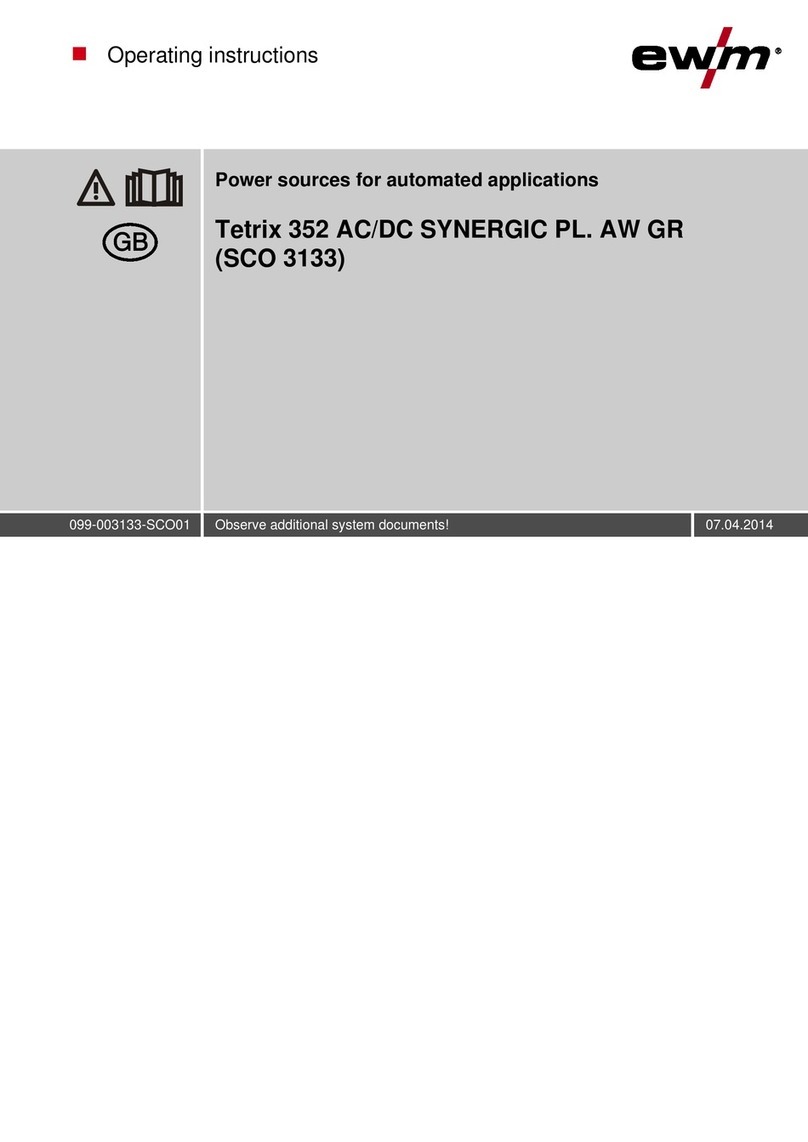
EWM
EWM Tetrix 352 AC/DC SYNERGIC PL. AW GR operating instructions
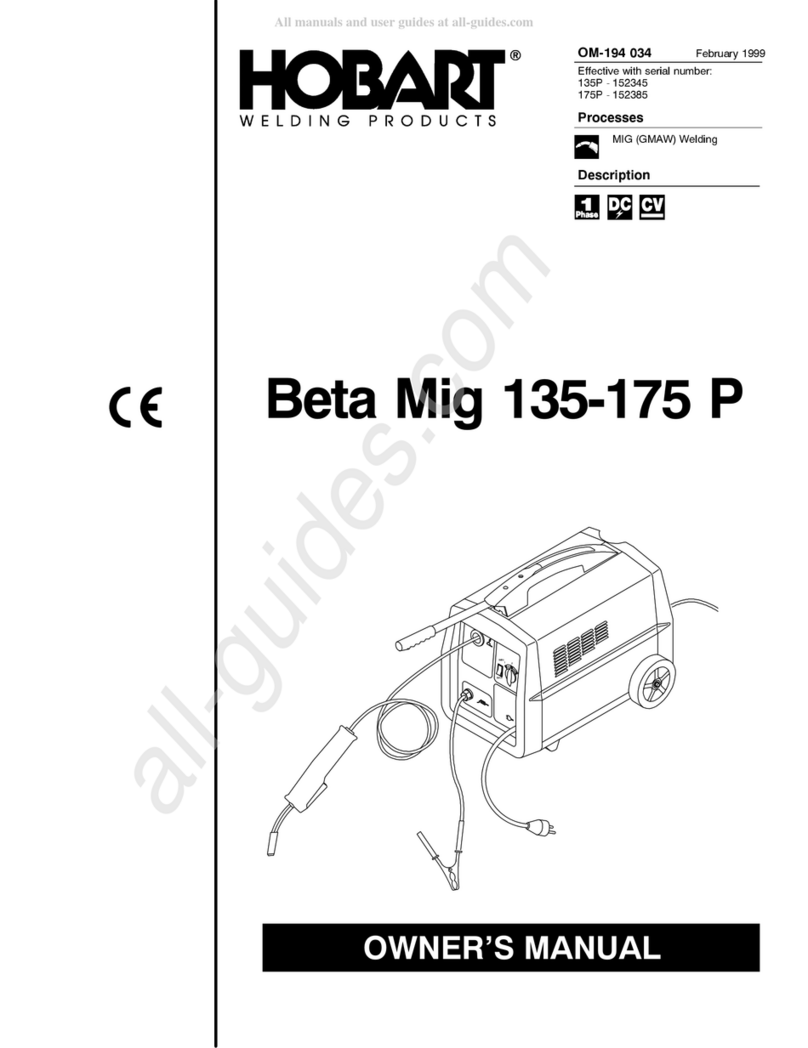
Hobart Welding Products
Hobart Welding Products Beta Mig 135 P owner's manual
